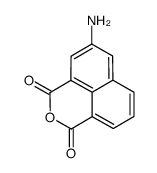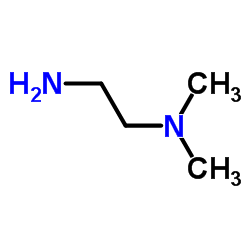69408-81-7
| Name | 5-amino-2-[2-(dimethylamino)ethyl]benzo[de]isoquinoline-1,3-dione |
|---|---|
| Synonyms |
Amonifide
5-amino-2-[(dimethylamine)ethyl]-1H-benz[de-]isoquinoline-1,3-(2H)-dione amonafide 1H-Benz[de]isoquinoline-1,3(2H)-dione, 5-amino-2-[2-(dimethylamino)ethyl]- AS-1413 5-Aminomitonafide Nafidimide Benzisoquinolinedione Quinamed Amonafidum [Latin] 5-Amino-2-[2-(dimethylamino)ethyl]-1H-benzo[de]isoquinoline-1,3(2H)-dione 2-(2-dimethylaminoethyl)-5-aminobenzo[de]isoquinoline-1,3-dione 5-amino-2-(2-(dimethylamino)ethyl)-1H-benzo[de]isoquinoline-1,3(2H)-dione Xanafide |
| Description | Amonafide is a topoisomerase II inhibitor and DNA intercalator that induces apoptotic signaling by blocking the binding of Topo II to DNA. |
|---|---|
| Related Catalog | |
| Target |
Topoisomerase II |
| In Vitro | Amonafide is a topoisomerase II inhibitor and DNA intercalator that induces apoptotic signaling by blocking the binding of Topo II to DNA[1]. Amonafide produces protein-associated DNA cleavage, single-strand breaks (SSB) and DPC and DNA double-strand cleavage. Amonafide (Nafidimide, 400 nM-2.4 μM) reduces the colony-forming ability of the leukemic cell lines in a dose-dependent manner[2]. Amonafide (0.05-0.4 μg/mL) reduces several tumor growth. However, Amonafide is active against only 12% of tumors compared with standard agents (5-fluorouracil, mitomycin C, cisplatin, and etoposide), which are active against more than 40% of tumors in the human bone marrow inhibitory range[3]. Amonafide inhibits the growth of HT-29, HeLa, and PC-3 cell lines, with IC50s of 4.67, 2.73, and 6.38 μM[4]. |
| Cell Assay | In experiments measuring survival following 1 h drug treatments, 2 × 106cells are resuspended in 2 mL warm (37°C) HBSS with 5% PCS; the appropriate drug (Amonafide) level is attained with the addition of less than 50 μL. Cells are incubated for 60 min at 37°C after which 10 mL ice cold PBS is added. The cells are then centrifuged at 200 × g for 10 min at 4°C. The wash is repeated once and the cells are resuspended in HBSS with 5% PCS and added to the agar-medium mixture for assessment of surviving clonogenic cells[2]. |
| References |
| Density | 1.3±0.1 g/cm3 |
|---|---|
| Boiling Point | 500.2±35.0 °C at 760 mmHg |
| Melting Point | 162-164ºC |
| Molecular Formula | C16H17N3O2 |
| Molecular Weight | 283.325 |
| Flash Point | 256.3±25.9 °C |
| Exact Mass | 283.132080 |
| PSA | 68.33000 |
| LogP | 0.06 |
| Vapour Pressure | 0.0±1.3 mmHg at 25°C |
| Index of Refraction | 1.681 |
| Storage condition | -20°C Freezer |
CHEMICAL IDENTIFICATION
HEALTH HAZARD DATAACUTE TOXICITY DATA
MUTATION DATA
|
|
~99% 
69408-81-7 |
| Literature: Quintana-Espinoza, Patricia; Garcia-Luis, Jonay; Amesty, Angel; Martin-Rodriguez, Patricia; Lorenzo-Castrillejo, Isabel; Ravelo, Angel G.; Fernandez-Perez, Leandro; Machin, Felix; Estevez-Braun, Ana Bioorganic and Medicinal Chemistry, 2013 , vol. 21, # 21 p. 6484 - 6495 |
|
~% 
69408-81-7 |
| Literature: Journal of Medicinal Chemistry, , vol. 50, # 17 p. 4122 - 4134 |
|
~83% 
69408-81-7 |
| Literature: Cui, Lei; Zhong, Ye; Zhu, Weiping; Xu, Yufang; Qian, Xuhong Chemical Communications, 2010 , vol. 46, # 38 p. 7121 - 7123 |
|
~% 
69408-81-7 |
| Literature: European Journal of Medicinal Chemistry, , vol. 47, # 1 p. 546 - 552 |
| Precursor 5 | |
|---|---|
| DownStream 1 | |





![N-[2-(Dimethylamino)ethyl]-3-(acetylamino)-1,8-naphthalenedicarbimide structure](https://image.chemsrc.com/caspic/485/69409-02-5.png)